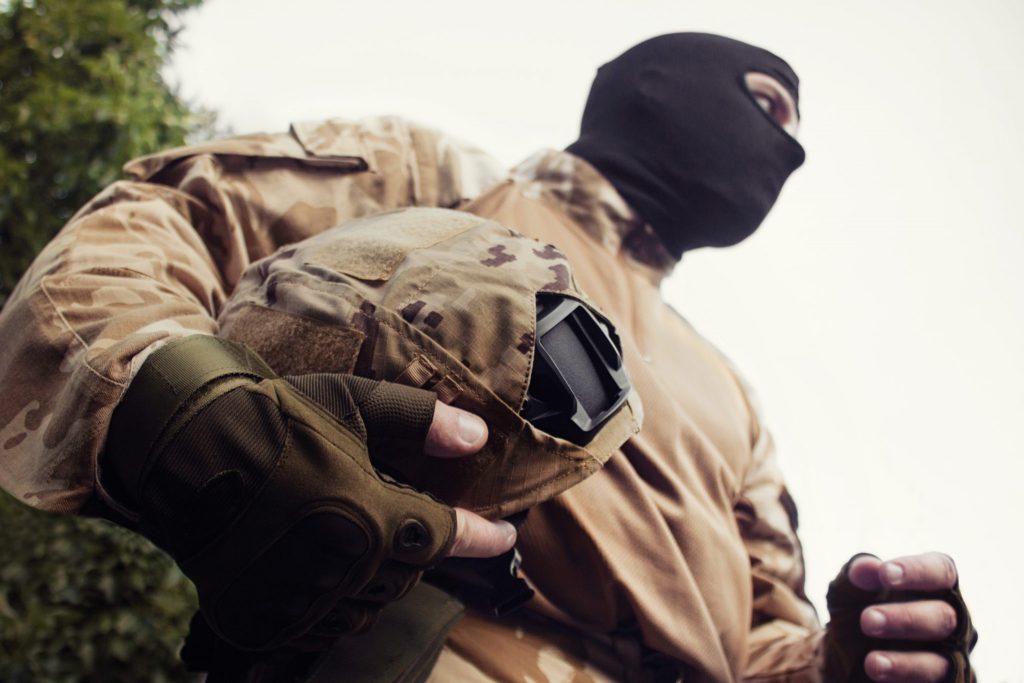Get started on your Homeland Security Degree at American Military University. |
By Wes O’Donnell, Managing Editor InMilitary.com and InCyberDefense.com. Veteran U.S. Army and U.S. Air Force. In addition to his MBA, Wes O’Donnell has a B.A. in International Relations, has studied Russian military history extensively and speaks conversational Russian.
I recently interviewed five Ukrainian soldiers who are fighting against Russian-backed separatists in the Donbas region of eastern Ukraine. During my interview, I jokingly asked one young soldier, who calls himself Myhalych, “Why do Russian and Ukrainian soldiers always wear balaclavas?”
After a long pause, he stated, “I mean no disrespect, Sergeant O’Donnell, but that is a silly question.”
The balaclava, commonly known as the ski mask, originated in the Ukrainian town of that name during the Crimean War battle there in 1854. British troops wore the headgear to keep warm.
Later, in the Soviet Union, the balaclava was a standard issue uniform item for many units across the Red Army. Today, its use has spread beyond eastern Europe to police, SWAT, special forces and terrorist organizations around the world.
During the Irish War for Independence and “the Troubles”, members of the Provisional Irish Republican Army (IRA) wore balaclava masks to conceal their identities.
Why Is Use of Masks So Integral for Russian And Ukrainian Fighters?
The importance of wearing balaclava masks is tied to a fighting tactic the Russians have used for more than 100 years. This Russian military doctrine is called “maskirovka” and covers a broad range of military deception measures.
At its core, maskirovka is designed to sow confusion. A 1988 Pentagon study of the technique says “Maskirovka may be conducted in any environment to deny information to sensors.”
Writing for the Moscow Times, Michele A. Berdy states, “маскировка [Something masked] has a broader military meaning: strategic, operational, physical and tactical deception. Apparently in U.S. military terminology, this is called either CC&D (camouflage, concealment and deception) or more recently D&D (denial and deception). It is the whole shebang — from guys in ski masks or uniforms with no insignia, to undercover activities, to hidden weapons transfers, to starting a civil war but pretending that you’ve done nothing of the sort.”
In Ukraine, however, balaclavas are “maskirovka” at its most pragmatic.
Referring to the 1988 Pentagon study, the balaclava denies information to the most basic of sensors, the human eye. It is difficult for a nation to act or decide on a course of action when aggressors do not wear insignia and conceal their identities.
The Russians aren’t riding into Ukraine by the hundreds of thousands on the backs of tanks. Instead, they operate on a much subtler level, sowing discord and insurrection by whipping up a nationalistic fervor among ethnic Russians living in the Donbas.
This concealment provides the Russian government with some level of deniability, despite NATO intelligence reports that clearly show Russia has boots on the ground in Ukraine. Regardless, the camouflaging of national identities has caused some level of uncertainty among Western allies.
Maskirovka Relies on Plausible Deniability
Denial, in fact, is one of the core tactics of maskirovka. After the Russian invasion of Crimea in 2014, it was clear that Russian special forces (Spetznaz) had seized government buildings. But Putin gave a news conference the following day denying that Russian soldiers were in the country.
When journalists asked Vladimir Putin where the troops in Crimea came from, the Russian president answered, “There are many military uniforms. Go into any shop and you can find one.” With a straight face, Putin assured journalists that the “little green men,” as they have come to be called, were “local self-defense units.”
Five weeks later, Putin admitted that Russian troops had been deployed to Crimea after all, but maskirovka had served its purpose: confuse your adversary. According to the BBC, it took some time for NATO commanders to figure out the “size and scale” of Russia’s invasion, an invasion the Kremlin constantly denied.
To complicate matters, the Armed Forces of Ukraine also wear balaclavas as part of their standard issue uniform. It is a visual affirmation of the closeness that once existed between Russia and Ukraine.
Masks and Maskirovka Are Common Military Tactics in Eastern Europe
Both the balaclava and maskirovka serve a definitive military purpose in eastern Europe. Russia has spent decades perfecting this doctrine and is arguably the world’s most proficient actor of military deception. Western intelligence organizations would do well to take note of Russia’s extensive use of this doctrine in past encounters with the West.
As for Myhalych, wearing a ski mask is just as essential as wearing combat boots or keeping your weapon clean. Perhaps asking why Russian and Ukraine soldiers wear balaclava masks might have seemed like a “silly question” to Myhalych, but as a former American soldier, I can say that silly questions sometimes evoke the best answers.
This article appeared originally on InCyberDefense.com


Comments are closed.